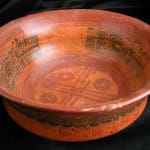Mayan Polychrome Bowl, 300 CE - 900 CE
Terracotta
8.25 x 3
PF.5660
Further images
Much like some believe ancient spirits continue to haunt the earth long after their death, sacred objects continue to retain their spiritual powers, accumulated through centuries of reverence, long after...
Much like some believe ancient spirits continue to haunt the earth long after their death, sacred objects continue to retain their spiritual powers, accumulated through centuries of reverence, long after the civilization that created them fades into oblivion. This object is one such example. The interior rim of the bowl has been painted with a coupling of two black pseudo-glyphs repeated four times. These rectangular glyphs both combine the same geometric elements: dots, dashes, grid patterns, curves, and lines. They are quite similar in form to the red glyphs that decorate the exterior band of this bowl. Here the glyphs are clustered together in four groups of three. Two abstract bands frame the upper half of this band. The lower ring is a diagonal grid pattern, topped by a narrow band of small, red triangles. Perhaps the most interesting feature of this vessel is the bottom. A series of diagonal lines have been indented in the sloping base of the bowl, radiating outwards like the petals of a flower. Discovered inside a tomb, buried next to a fallen ruler or dignitary, this bowl was as essential in the afterlife as it was in this world.





